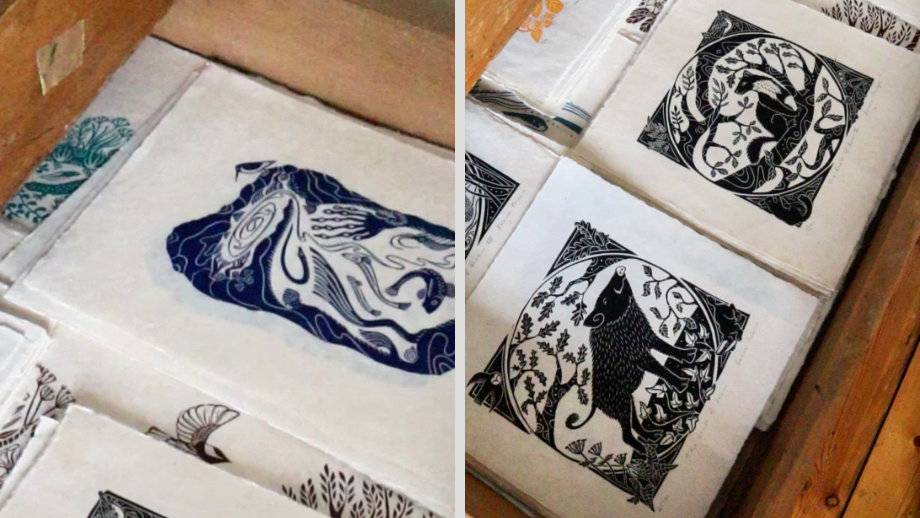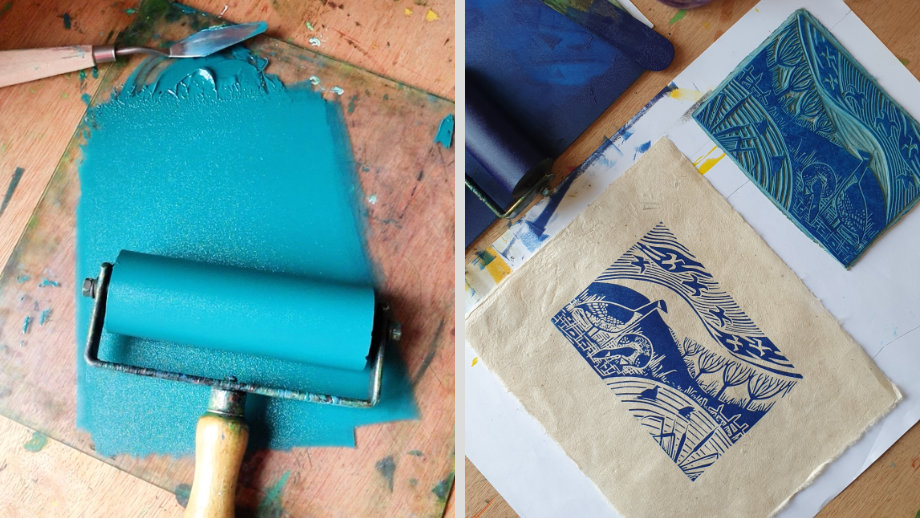A chat with illustrator Becca Thorne

Becca Thorne is an incredibly talented artist and illustrator and is the creative brain behind our beautiful new ball band illustrations. Becca uses lino printing techniques to create stunning designs, and we love how her work perfectly captures the essence of our yarn ranges. We were thrilled that Becca had time for a catch up with us recently, and we had the chance to ask her all our burning questions…
What does a normal working day look like for you? Or is every day completely different?
I work from home, so I’m usually in the studio by 8:30am. I always start the day by checking emails and packing any orders, which can take half an hour or all morning. The actual creative work varies depending on what stage I’m at with a project. In the early stages, I might spend the whole day doing research and quick studies of the subject matter. Most of my commissioned work is based around history or the natural world, so there’s always a lot of fun things for me to learn and explore, and I might need to go out and forage some plants or take photos to draw from. Other days will be spent refining a design on my iPad, which I usually do curled up on the studio sofa. Right now, I’m at the end stage of two book commissions, so most of the last month has been spent sitting at my desk carving lino blocks. It’s one of my favourite parts of the job, but I have to remind myself to stand up and stretch every now and then; it’s easy to get lost in the process! Next, it’ll be time to print all the carved blocks and hang the prints to dry for a few days before I can scan them. I’ve got another job ready to go, so while the prints are drying, I’ll the start researching and sketching quick studies for that, and the whole process will begin again.
What initially drew you to linocut as a medium? And how long have you been doing it for?
I learnt linocut at Falmouth College of Arts during my Illustration degree, 20+ years ago. Before that I worked mostly in pencil and was obsessed with painstakingly sketching fine details and making everything ‘perfect’ — which meant a lot of self-criticism and unrealised ideas! My visual studies tutor, the wonderful artist Marilyn Towndrow, encouraged me to explore print more, and I found that working in negative, and focussing on shape and movement, really loosened me up as an artist. I was able to lose myself in the composition rather than obsessing over isolated details. I love the physical processes of linocut — hand-carving, hand-printing — and back then I particularly liked that I could do it at my desk in the illustration studio, so I could stay with my friends and didn’t need to trek up to the print workshop to use specialist equipment. I’ve still got the teaspoon I pinched from the studio sink to hand-burnish my prints, and I frequently still use a teaspoon to burnish now. Lino is such an accessible medium!

You make very small illustrations for us (approx. 5 x 3cm), what are the considerations when working on such a small piece?
3cm is really tiny, so I have to scale up to allow me to carve the illustrations – I print them approximately 4 times bigger than the final illustrations. But I have to ensure that anything I carve at that scale remains visually legible when shrunk down to size, so I have to stop myself getting carried away with too much detail!
How different is the process of working with a brief to working for yourself?
I love working to a brief, and the challenges of learning about and drawing something that I might not have considered on my own. Client briefs naturally have lots of specific requirements that are set by someone else — subject, size, shape, audience, colour — and it’s my job to figure out how to work within those specs. I find the restrictions can actually be quite freeing — it’s a bit like when you end up with a glut of one vegetable, or need to make dinner from whatever’s left in the cupboards — I love the challenge, and it can lead to unexpectedly wonderful things!
That said, it can sometimes be hard to accept if a client wants slightly different things to you, and there’s rarely much opportunity to fully experiment with a client brief. Client deadlines tend to be quite tight and I’m often working on a few different briefs at a time, so I have to be pretty focussed. I haven’t had the chance to work on anything of my own for about a year, so I’m keen to find time to explore my own ideas.

What is it you love about making art? What keeps your creativity topped up?
My love of nature, history and folklore are intrinsically linked to my art, and I consider myself very lucky, not only that I get to do this for a living but that I was able, and encouraged, to explore all of it as a child. I’ve always been wildly curious — I’m not content to see a bug or a plant and think it’s pretty, I have an inherent need to find out exactly what it is and learn absolutely everything I can about it. I research constantly, and that drives my personal practice. I love that my job allows me to bring everything from my life together — if I go for a walk in the wilds I’m researching and gathering inspiration all the time, without even trying. It’s the same if I’m on the allotment, or in the garden, or reading a book. Everything is connected.
What is your favourite creative nook, (or your favourite objects) in your studio?
I love so much about my studio. It’s our spare room, which looks out over our garden and gets loads of light. My partner built me a fold-out printing table that drops down from the shelves so I can stow away all my inks and make a little more room when we’ve got guests staying. The shelves are full of books and magazines that I’ve illustrated, old sketchbooks and inspirational things: knick-knacks, bones, fossils, shells, books and more. There are also a couple of wonderful, practical reminders of people who are no longer with us: my printer/scanner sits on a 1950s drop-leaf Formica table that belonged to my nan; and my plan chest was rescued for me years ago from an old art college, by musician and former head of Leicester Print Workshop, Lucy Phillips, who died suddenly very recently. The top of the plan chest is covered in a colourful melee of paint and ink from its former life, and whenever I look at it, I think of Lucy.

Do you have any tips for our readers looking to start printmaking? Are there any handy tips or rules for folks to bear in mind?
I’d definitely encourage people to try a local class — loads of people offer workshops, and the printmaking community is very generous and welcoming. Teachers provide the tools and materials, and it’s so much easier (and more enjoyable) to get to grips with the process in-person. If you’re looking to go further on your own, you don’t need to spend loads on fancy tools for carving and printing. Cheap multi-pack carving tools are generally pretty good, and a wooden spoon (or even a teaspoon) is all you need to hand-burnish — it’s way more forgiving than a table-top press, easier on the hands than a bamboo baren, and you’ve probably already got one! Cheap kid’s sugar paper is also great for printing on when you’re starting out.
The things you need to pay attention to are ink and rollers. For linoprinting, you should source actual relief printing ink, not paint, and avoid those big, cheap tubes – they’ve scuppered many an aspiring printmaker! I’d recommend Speedball water-based inks for beginners at home, as they’re easy to clean up with water but have a decent viscosity and depth, and they usually dry in under an hour. I’d recommend the red, plastic-handled rollersby Esdee for rolling out and inking up. They’re cheap but they work, and they’re very durable, which is why schools and colleges always use them. Or try stamp pads, they’re a great option for smaller pieces and you can apply them directly to the block without a roller.
Do you have anything fun in the works over the next year?
I’ve worked on a few things that are coming out in the next couple of months: I illustrated the cover of Michael Arnold’s new historic novel The Savage Isle, which comes out in April. It’s about the Roman invasion of Britain, and I had a lot of fun drawing waves and Roman ships. I really enjoyed illustrating the cover of Richard Negus’ Words From The Hedge: A Hedgelayer’s View of The Countryside, which is released in May. In a first for me, I illustrated the English and German language labels of some new spice mixes from Schwartz, which should be in UK and Swiss shops from May, and later this year in Germany. Fans of YA fantasy will be excited to hear that Australian publisher Book Addiction are releasing a 30th anniversary limited edition box set of Garth Nix’ Old Kingdom series, which I’ve been illustrating over the past year, and promises to be absolutely beautiful. I believe that’s also scheduled for release in May (May’s a big one!). I can’t really tell you much about the other things I’m working on yet, but I’m really looking forward to carving out a bit of time to work on personal projects. I’ve got a couple of great events lined up for the summer: the BS4 Arts Trail, which I co-organise, is happening in my corner of south-east Bristol on 14th & 15th June, and the following weekend I’ll be at On Paper Festival in Bath. I’ve got so many ideas that I’ve been sitting on for months, so I’m hoping to be able to realise some of them ahead of those dates!
Where is the best place for folks to keep up to date with everything you’re up to?
You’ll mostly find me on Instagram, where I share work in progress, personal work, published illustration and everything else: @b_thorney But I’m also starting to get to grips with Bluesky, where things are a bit quieter and less advert-heavy – Come join me over there if you’re so inclined! @beccathorne.bsky.social Or you can see everything in a more formal setting over on my website beccathorne.co.uk
Thank you so much, Becca for chatting with us! Make sure to check out Becca’s social media and website for more info, and let us know what your favourite ball band illustration is!